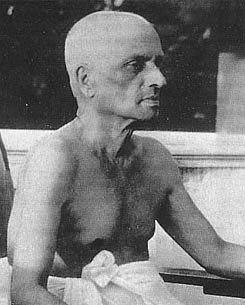I have no mine-ness, attachment or egoism. I am eternal, non-doer, and all-purity, self-dependent and self-luminous. Attribute less; changeless and unconditioned, I am the abode of Love, stainless, the one without second and ever peaceful
Life
Birth: Sri Atmananda (Krishna Menon) was born into an illustrious family in the village of Peringara, in central Travancore, India on December 8, 1883.
Realization: Sri Atmananda started an intense spiritual practice the same day that his teacher (Yogananda) left, beginning with the path of devotion, selfless love. This he covered in six months. He then started on the hard course of yogic disciplines. This too he completed in a few months, though he underwent a strange but temporary bodily paralysis in the course of it. In the end, he was able to enjoy long and deep trance states at will. These states, however, did not satisfy him since they were limited in time, and were the result of intense effort. He was now sure that the Truth must be naturally uncaused, permanent, and self- luminous. After the yogas, he gladly and easily took at last to the path of wisdom and self-inquiry, “jnana-sadhana.” On this path he was to visualize Ultimate Truth in a very short time.
Death: Sri Atmananda died on the morning of May 14, 1959
Teaching Style: Sri Atmananda gave the whole Truth, expounded in a connected and direct manner. By argument and the clearest logic, in spite of all resistance, their attention was directed to the Real Being beyond the body, senses, and mind, to the Non- dual experience of one’s own Real Nature, to immediate Realization or visualization of the Truth. This they were asked to hold to, and become more and more familiar with as often as possible, experiencing the Ultimate Truth every time.
Many more received substantial spiritual help even though they were not disciples. He said, “I accept only those in whom I find the proper attitude of surrender, or true devotion to Truth.”
After retirement from government service, Sri Atmananda devoted all his time to his disciples, residing mainly at his old country house, “Ananda Vadi” on the river Pampa. He was against institutions or successions of any kind in relation to spirituality. Instead, he asked his disciples and his children to live like a harmonious family, remembering that the spiritual relation of each one is always directly with the spiritual teacher alone.
Fame: Sri Atmananda was bright in his studies, fearless, and completely honest. He started writing poetry about the age of fourteen. His educational career was outstanding. He had some early interest in religion which diminished during his teens. Sri Atmananda met a sanyasin (holy man) Yogananda who was very different, impressive and charming in every way. He received all instructions needed for spiritual attainment of the Ultimate. Towards the end of this devotional path he wrote his “Radhamadhavam,” 48 verses in Malayalam, later to be translated into English.
Legacy: Sri Atmananda taught his immediate family, and his extended family of uncles and in- laws, absorbing them into the Ultimate along with his other disciples. Of the five disciples of Yogananda only Sri Atmananda was permitted to take on the role of teacher, and to accept disciples. Accordingly, he accepted his first few disciples soon after 1923.
Teachings
According to Sri Atmananda, it is absolutely necessary to know what you are and what your standpoint is, if you want to arrive at the right knowing, or to put it another way, to see the right perspective. It is not enough to only investigate the waking state for that purpose, because your experience extends also into the dream and into deep (dreamless) sleep states. Let us then initiate an investigation into these three states. You will discover that the I-principle (the true unchanging Self) is continuously present in each of the three states. The body, the senses and the mind are present in one state, but they are not there in the others. From that it follows that the I-principle is unjustly coupled with the body, the senses and the mind and that in reality it is independent of these three. That can be seen in the deep (dreamless) sleep, where it shines in all its bliss. You can see there that the pure Consciousness is a deep Peace. When you awaken out of the deep sleep you then say that you were happy (that you slept deeply and peacefully).

